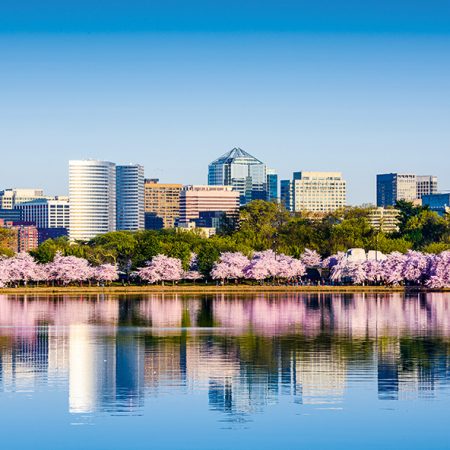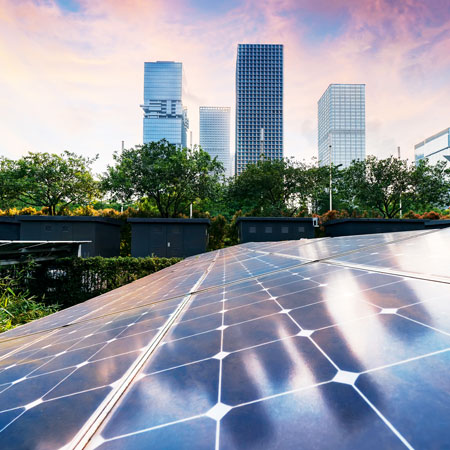The office market is exposed to the risk of reduced demand due to the rise of hybrid working. We have estimated that companies may require about 10% less office space on average in the coming years due to changes in working patterns. Nevertheless, market evidence shows that corporate demand for the healthiest, most energy efficient—so-called ‘green’—offices remains strong, driven by growing ESG commitments and competition for talent.
In many markets, green certifications, such as BREEAM, LEED and WELL, represent high-performing and/or energy-efficient buildings. We analysed the office stock across 20 cities and found that green certified offices account for 22% of total stock on average, ranging from less than 15% in Los Angeles and London City to over 40% in Warsaw, San Francisco, and New York. Overall, green certified stock is in short supply. In some jurisdictions, such as Germany, the real supply of energy efficient buildings is higher due to long standing, stringent regulations around energy performance.
New supply does not meet demand for green offices
Across all markets, the majority of the green office stock is already occupied, and companies rely heavily on new developments to satisfy their requirements. Developers are responding to the challenge, motivated by the regulatory trend and the rental premium achieved by newly built certified stock, versus older uncertified stock. As a result, the majority of newly constructed Grade A office stock across the key global office markets, is much greener. ‘Tenants are prepared to pay higher rents for new office properties, which have achieved some sort of green certification. The price differential varies from more than 15% in Singapore and Bangkok to less than 4% in Tokyo,’ says Sam Crispin, Regional Head of Sustainability & ESG, Asia Pacific at Savills.
The average annual delivery of new or refurbished office space across our survey area by 2024 will be 22% higher than the past five years annual average. Nevertheless, it only corresponds to 11 months of a typical annual take-up, adjusted downwards by 10% due to the impact of hybrid working. The new supply ratio can drop further, as several schemes are being put on hold due to rising energy costs and supply chain disruptions. The pace of new construction is also likely to slow down in the future, due to increasing focus on reducing embodied carbon emissions tied to the building process.
The cities where the new supply ratio is the lowest (below one year’s take-up) are the US cities, which have very low development pipelines and dated available stock, followed by Frankfurt, Madrid, Seoul, Paris, Amsterdam, London, and Barcelona.
While in Europe vacancy rates are low, at 7% on average, availability in the US is higher, over 20% in some markets, legacy of the previous market cycle. However, due to stricter lending rules post Global Financial Crisis, supply has not kept up with demand for green office spaces due to the high cost of land and construction in 24-hour gateway cities.
Higher gas prices, national and corporate carbon reduction targets, and rising levels of investment into energy efficiency improvements will heighten competition among tenants for energy efficient space in order to reduce energy bills. The COVID-19 pandemic has brought to a fore the importance of healthy spaces too. This is likely to widen the green premium as businesses in less energy-efficient and heathy buildings spend increasing amounts on operating their premises.
Regulation will drive retrofitting
The pressure to improve the energy performance of older buildings will further intensify as governments tighten regulation in order to reduce greenhouse emissions and meet their net zero targets. The European office market will be affected by the requirement of a minimum EPC rating for commercial leases. In the Netherlands offices with EPC ratings below C will be deemed unlettable by next year, while the UK Government is considering implementing a minimum EPC rating B by 2030.
In the US, some cities such as New York, Washington DC, and Boston, have adopted minimum energy performance standards for commercial buildings based on the Energy Star Standard, a performance-based certification that is renewed annually. ‘Many green certifications do not track the building’s performance post certification, making it challenging to gauge true performance based on these accreditations alone. An annual assessment or reporting mechanism to track and monitor a building’s environmental credentials and health outcomes can incentivise landlords to keep improving their assets, while demonstrating to their current and prospective tenants that they are taking action. These metrics can also be used to meet the landlords’ own ESG goals.‘ says Hyon Rah, Director, ESG Consultancy, Savills US.
The above-mentioned regulations are likely to accelerate renovation and retrofitting initiatives by investors and landlords who want to alleviate the risk of stranded assets in their portfolios. The challenge to meet the ‘green office’ deficit is enormous. Energy performance regulations have been introduced gradually and at different speed across the 20 cities we monitor. With 2010 as a reference year, we calculated that more than 70% of the office stock was built before this date, corresponding to about 1.9 bn square feet (175 millon square metres).
‘Green office’ deficit index
Our ‘green office’ deficit index ranks the cities based on: the volume of existing certified offices, volume of dated office stock (built before 2010), new supply ratio for the next two years, level of availability, and employment growth prospects.
The city with the highest challenge is Los Angeles, with 95% of its stock built prior to 2010 and only 13% of the stock green certified (BREEAM, LEED, WELL). Despite its high availability ratio of 25.1%, tenants are likely to be left with very little choice of energy efficient buildings due to extremely low new construction activity. Frankfurt and Madrid follow with a development pipeline that could only satisfy three to six months equivalent of occupier needs for space. Seoul is another market which is going to witness a drop in construction activity over the next two years. New supply corresponds to only about seven months of typical take-up and 70% of its stock built before 2010.
Overall, landlords will need to step up their efforts across all cities in order to meet the sustainability prerequisites, or else their assets may not be lettable and lose their value rapidly. This is important for occupiers as well, as they try to entice workers back into the office and gain a competitive edge in attracting and retaining top talent.



